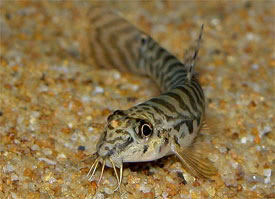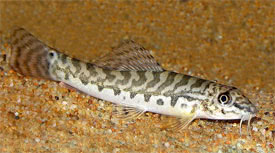
 Magyarul / Hungarian
Magyarul / Hungarian




- Scientific name: Acanthocobitis botia
- Synonyms: Botia nebulosa, Cobitis botia, Nemacheilus botia, Nemacheilus botia botia, Nemachilus mackenziei, Noemacheilus botia
- Common name: Zipper Loach, Mottled Loach, Eye-Spot Loach, Sand Loach, Striped Loach
- Group: Loaches
- Habitat: Asia; Pakistan, India, Nepal, Bhutan, Bangladesh, Myanmar (Burma), China and Thailand.
- Size: 8-10 cm
- Biotope: Lives in fast-flowing streams, and smaller rivers, with rocky and sandy bottom often with some leaf-litter over the substrate.
- Social behavior: Peaceful loach that can be kept in a community tank with other peaceful fish that swim in the upper part of the water column. The fish become shy or skittish when kept singly or in a small group.
- Diet: Omnivorous; in nature it mainly eats insect larvae. In the aquarium it can be fed with small live and frozen foods, and quality dried foods.
- Breeding: Very rare in aquarium.
- Tank: Minimum 60 litres
- Population: 5-8 fish for 75 litres
- Decoration: Use a sand as substrate. Build lots of shady hiding places with roots and larger stones. Place some dried leaves into the tank to mimic their natural habitat. Water movement should be strong.
- Temperature: 21-26 °C
- pH: 6.5-7.2
- Hardness: 15-25 NK°
- Lifespan: 5-8 years
Description: Zipper Loach is a good choice for beginner aquarists as the fish is relatively hardy, and peaceful. Its light-brown body covered with irregular dark, saddle-shaped markings along the dorsal surface and upper body which resembles a clothing zipper. There is a dark eye spot at the top of the caudal peduncle, which more intense in younger fish. The mouth has four pairs of barbels. The transparent fins are marked with brown bands. During feeding the Zipper Loach will sift through the substrate, filtering through its gills, looking for microscopic food, so sandy substrate is recommended.
Male fish are slimmer, and have a suborbital groove that extending from below the eye which is absent in females. Acanthocobitis botia is not bred commercially, and most of the fish available in the hoby are wild caught. Breeding in the aquarium is very rare, and usually accidental, some reports are available, where only a few fry survived, as the parents ate the eggs. Zipper Loach breeds in the wild around May to June.


